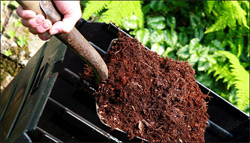How to Compost
 Here you will learn simple yet helpful tips on how to making use of the garbage found around the house. Instead of burning them to ash, we will teach you how to compost, a helpful way in keeping your soil healthy and nourished. Many people call the black crumbly material that is the result of combining some biodegradable stuff you found in your home “black gold” because it is very rich in nutrients that will make your soil happy. This black gold material is called humus created by the bacteria and other microorganisms that break down the mix you have created turning it into a rich fertile earth that you can add in your soil. The result of finished compost is humus filled with minerals and micronutrients and now ready to be added in soil so your plants could grow healthier.
Here you will learn simple yet helpful tips on how to making use of the garbage found around the house. Instead of burning them to ash, we will teach you how to compost, a helpful way in keeping your soil healthy and nourished. Many people call the black crumbly material that is the result of combining some biodegradable stuff you found in your home “black gold” because it is very rich in nutrients that will make your soil happy. This black gold material is called humus created by the bacteria and other microorganisms that break down the mix you have created turning it into a rich fertile earth that you can add in your soil. The result of finished compost is humus filled with minerals and micronutrients and now ready to be added in soil so your plants could grow healthier.
Many people opt to learn how to compost instead of using expensive chemical fertilizers. Composts are a great alternative in fertilizing the soil and it is safe, healthy and organic. There are a lot of cons in using chemical fertilizers and one of them is it can harm the sensitive roots of your plants because it can be really harsh due to its ingredients which include heavy metals like lead, arsenic and cadmium.
Now, to compost, follow these easy steps:
1. Find a bin or create one where you will place your compost – There are large bins that can be bought in hardware stores if you are going to create large amounts of humus. For small amounts, you can compost in a pile on the ground, or dig a small pit.
2. Fill your bin/pit with all the “composting ingredients” – Your bin must have a balanced mixture of the following: Green stuff (weeds, leaves, grass cuttings, fruits and vegetables, etc.), brown stuff (autumn leaves, dead plants and weeds, old flowers, straw and hay, etc.), other biodegradable items (paper towels, paper bags, egg shells, etc.), air, water (compost must always be damp), temperature (must be a bit warm), and soil (sprinkle garden soil lightly in the mixture).
3. Mix the ingredients so that they come into contact with one another – Avoid compacting large quantities of greens together, instead layer them carefully so that they are equally distributed. On each layer, spray a bit of water to make them moist.
4. Regularly turn your pile – Do this once every week or so. This helps air flow in the compost easily, encouraging aerobic decomposition and discourages anaerobic decomposition which makes your pile smell very stinky. Turning the pile makes your mix have a growth of bacteria that creates a nice, sweet smelling pile that decomposes faster.
5. Avoid these things that slow down decomposition – Do not add these in your compost: cooked food, meat scraps, bones, fish, oil or fat, bread, pasta, nuts, nappies, coal, and pet or human feces (except for manure of herbivores like horses and rabbits). These don’t break down easily and can get very slimy which holds down the rotting process.
6. Get ready to harvest your compost – If everything went well, you’ll have a thick brown mixture that you can sift through a mesh to break down large chunks. Use your humus to spread on your garden beds for a healthier soil.
It is very easy to learn how to compost and it helps you transform your dry land into a healthy and rich soil that will grow healthy and organic plants. Not only does it make your soil more fertile but it also saves your money.

